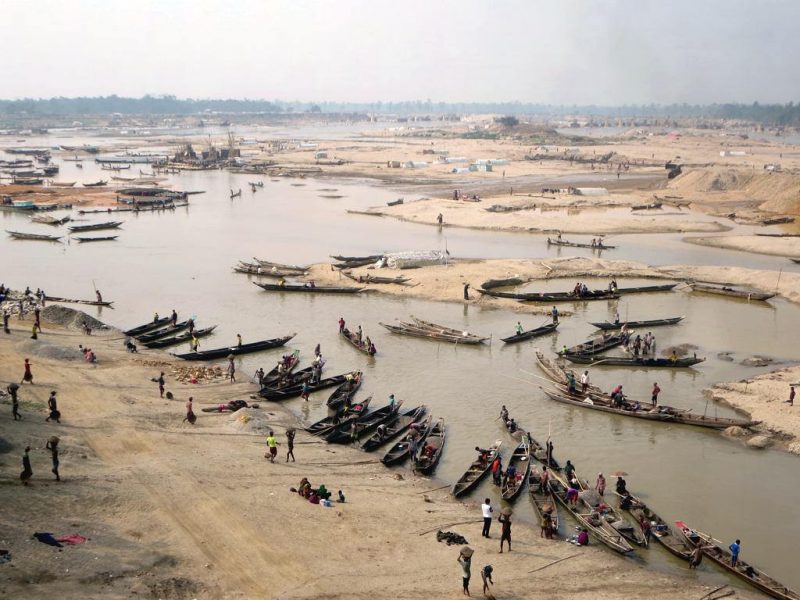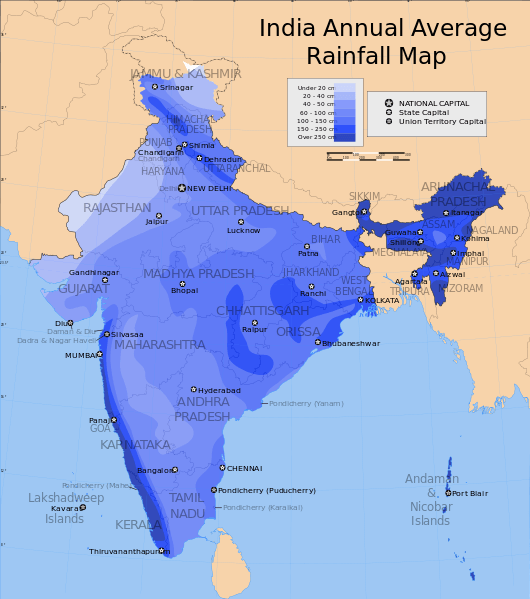
The monsoon is a tropical climate system with a strong seasonal rain and wind pattern that affects more than 50% of the world’s population. The Indian summer monsoon is a key component of tropical climate. It is mainly driven by the temperature contrast between the Indian Ocean and the Tibetan Plateau in the Himalayas as land heats and cools faster than the ocean through the year.
During summer, the southwest monsoon brings wind from the Indian Ocean north onto land, transporting large amounts of moisture in low-pressure systems. In this time, maximum rainfall occurs in northern India, Bangladesh, and the Bay of Bengal. During winter, the northeast monsoon shifts the maximum rainfall zone south, away from land into the open equatorial Indian Ocean. In this time, the wind direction reverses and blows dry winds containing dust from the Tibetan Plateau south into the Indian Ocean.

Map of annual rainfall in India. Credit: Planemad via Wikimedia Commons, licensed under CC-BY-SA 3.0
It is thought that this annual cycle of winter and summer monsoon is mimicked on geological time scales by slow and cyclic changes in the orientation of Earth’s rotational axis. This axial precession leads to cyclic shifts of the equator to the north and south within a 26,000-year cycle. Summer monsoon strengthened when the resulting maximum amount of incoming solar radiation (insolation) shifted north of the equator and regulated the distribution of monsoonal moisture in the northern Indian Ocean. During enhanced winter monsoon the maximum insolation shifted south of the equator that brought drier and windier conditions to the northern Indian Ocean.
Following this logic, we investigated a sediment core from the deep Indian Ocean (3.7 km water depth) that was retrieved 8° north of the equator within the International Ocean Discovery Program in 2015. This 5-m long core preserved a record of monsoonal climate variability in the lower Bengal Fan over the last 200,000 years.
Our results basically confirm the insolation-driven concept, although the story turns out to be a bit more complicated. As with every geologic archive, establishing an absolute time scale is key to deciphering the chain of events. We were fortunate enough to have measured a number of climate and monsoonal indicators at high resolution, allowing for the correlation to a number of other, independently dated archives.
Most of the climate indicators we determined show strong variability on the precession band and vary at the same time as the orbital variations would predict, meaning there is no detectable lag time between the presumed orbital cause (forcing) and the monsoonal effect (response). This conclusion can be drawn from independent dating of variations in Earth’s magnetic field in our sediment core, and from independently dated moisture records obtained in Chinese caves that use the isotopic composition of stalagmites.
Accordingly, during insolation minima – colder and drier climate periods – descending dry air over the northeastern Indian Ocean could have enhanced a divergent surface circulation in the ocean. As a result, a shoaling thermocline could have brought colder and nutrient-enriched waters from the deeper in contact with the warmer, nutrient-depleted waters near the surface, thereby enhancing ocean productivity. This can be inferred from the fact that total organic carbon varies in this fashion at our site and that the origin of organic material is marine.
In addition, lower glacial sea levels, as well as stronger westward surface circulation in the northern Indian Ocean, favored the delivery of coarser-grained material through rivers to the lower Bengal Fan as indicated by the results of our grain-size studies. Insolation minima generally showed higher delivery of sediment to the Bay of Bengal, implying higher soil erosion on land. At the same time, the stronger northeast monsoon might have increased the wind-driven sediment supply to the fan system.
During insolation maxima – warmer and wetter periods – the situation reversed. There was less upwelling in the ocean, only finer-grained material was delivered to the fan system, soil erosion on land was reduced and wind-driven sediment supply diminished.
However, apart from strong insolation forcing, we detected some climate indicators that dominantly vary every 41,000 years. Such climate cycles respond to variations in the Earth’s axial tilt and are typically associated with Northern Hemisphere processes. High northern latitudes are most susceptible to changes in surface Albedo, the ratio of reflected to received irradiance that affected the past waning and waxing of Northern Hemisphere ice sheets and associated ocean circulation over glacial cycles. Total inorganic carbon, the ratio of calcium and titanium, as well as biogenic silica vary dominantly on orbital tilt frequencies, suggesting mobilization and transport of sedimentary material from land primarily during lowered sea levels and/or higher influence of the Northern Hemisphere westerly winds on the dust transport from the Tibetan Plateau.
Finally, the close resemblance of color variability in our sediment core and the climate record of Antarctic ice cores indicate a close relationship between high southern latitude and tropical Asian climate over multiple glacial cycles, likely through shifts in the position of the Intertropical Convergence Zone.
As a whole, our study reveals complex interactions of orbital drivers and the monsoonal responses in the Indian Ocean over the last 200,000 years, with a dominance of insolation-driven change over precession cycles.
These findings are described in the article entitled 200,000 years of monsoonal history recorded on the lower Bengal-Fan – strong response to insolation forcing, recently published in the journal Global and Planetary Change. This work was conducted by a team including Michael E. Weber from the University of Bonn, Hendrik Lantzsch, Jürgen Titschack, and Philipp Wolfgramm from the University of Bremen, Petra Dekens and Beth Holmes from San Francisco State University in San Francisco, Supriyo K. Das and Sandip Agrahari from Presidency University in Kolkata, Brendan T. Reilly from Oregon State University, Yasmina M. Martos from Goddard Space Flight Center, Carsten Meyer-Jacob from Umeå University in Umeå, and Alf Ekblad from Örebro University in Örebro.









